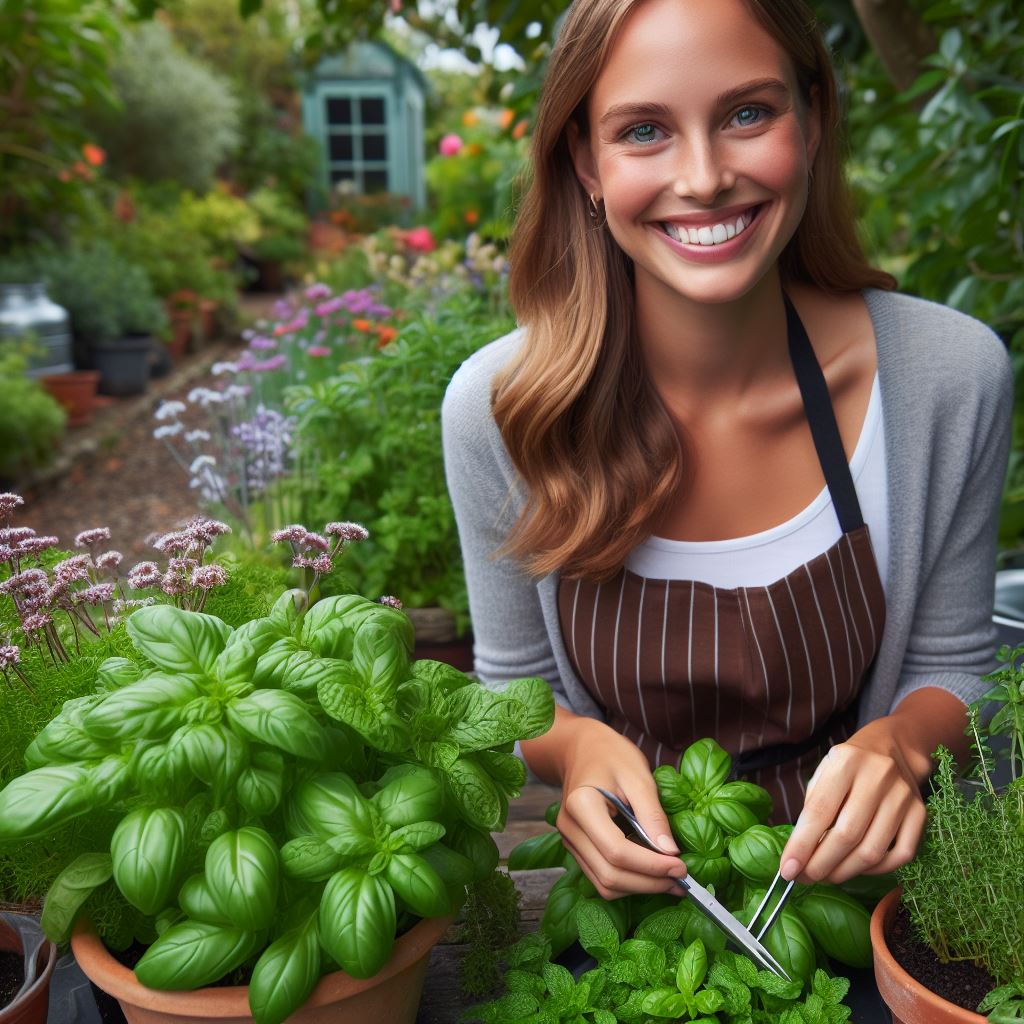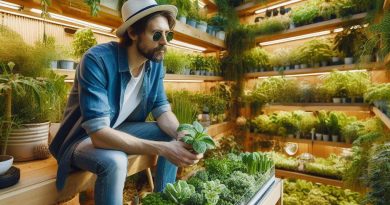Small Garden, Big Flavor: Growing Herbs Easily
Last Updated on February 18, 2024
Introduction
Have you ever wished you could step out into your garden and pick fresh herbs to elevate the flavors of your dishes?
Well, it’s easier than you think, even if you have limited space.
Growing herbs in a small garden can bring big flavor to your meals.
Herbs play a crucial role in enhancing the taste and aroma of food.
Whether you’re cooking a simple pasta dish or experimenting with exotic recipes, having a variety of fresh herbs at your fingertips can take your culinary skills to the next level.
The best part is that growing herbs doesn’t require a green thumb or an expansive garden.
You can easily cultivate a diverse range of herbs, even in a small space.
With the right tips and techniques, you can create a mini herb garden that will provide you with a constant supply of flavorsome ingredients throughout the year.
In this blog post, we will explore different methods for growing herbs in a small garden.
We’ll discuss the ideal herbs to grow, suitable containers, and the importance of proper sunlight and watering.
Additionally, we’ll provide helpful advice on harvesting and preserving your herbs for long-term use.
So, whether you’re a seasoned gardener or a novice, get ready to create a vibrant and flavorful herb garden right outside your doorstep.
Let’s delve into the wonderful world of growing herbs easily in a small garden!
Planning the small herb garden
A well-planned herb garden can provide a constant source of fresh flavors for cooking and add beauty to any small space.
Whether you have a windowsill, balcony, or a small patch of land, it is important to plan your garden carefully to ensure the success of your herb plants.
Planning involves assessing the available space and sunlight, as well as determining the number and types of herbs to grow.
Assessing available space and sunlight
- Choose a suitable location for the garden: Look for an area that receives at least 6-8 hours of sunlight per day. Most herbs require full sun to thrive and produce flavorful leaves. Avoid placing the garden in shaded areas or under trees that may obstruct sunlight.
- Consider the natural light requirements of different herbs: Some herbs, such as basil and rosemary, need full sun, while others like parsley and mint are more tolerant of partial shade. Understand the light requirements of the herbs you plan to grow and ensure that your chosen location can provide the necessary conditions.
Determining the number and types of herbs to grow
- Select herbs based on personal preferences and culinary usage: Consider the flavors you enjoy and the dishes you frequently prepare. Popular choices include basil, cilantro, thyme, and oregano. Grow herbs that you use frequently to optimize the benefits of your small garden.
- Take into account the available space and sunlight: Consider the size and growth habits of different herbs. Some herbs, like mint and sage, are more invasive and may require their dedicated space to prevent them from taking over your garden. If space is limited, opt for compact varieties or consider vertical gardening solutions.
By carefully assessing your available space and sunlight, as well as selecting herbs based on personal preferences and culinary usage, you can plan a small herb garden that thrives and provides an abundance of flavor.
Remember to regularly water, fertilize, and harvest your herbs to promote healthy growth and ensure a continuous supply of fresh herbs for your culinary adventures.
Read: Maximize Your Balcony: Top Herbs for Small Spaces
Preparing the soil and containers
In order to ensure a successful herb garden, proper preparation of the soil and containers is crucial.
This section will guide you through the necessary steps to create an ideal environment for your herbs to thrive.
Soil preparation for optimal herb growth
- Understanding the basics of soil pH, drainage, and structure is essential. These factors contribute significantly to herb growth.
- Soil pH refers to the acidity or alkalinity levels of the soil. Most herbs prefer a neutral pH around 6 to 7. Adjust the pH if necessary.
- Good drainage is vital to prevent waterlogging, which can lead to root rot. Avoid compacted soil by incorporating organic matter.
- The structure of the soil, whether it is sandy, clayey, or loamy, influences its aeration and water-holding capacity. Aim for a well-draining soil.
To improve soil fertility, it is advisable to add organic matter or compost.
This enhances nutrient content, promoting healthy herb growth.
- Compost is a fantastic option that enriches the soil with essential nutrients. It also improves soil structure and moisture retention.
- Apply a layer of compost and mix it thoroughly with the existing soil. This will boost its fertility and provide a rich growing medium.
- Organic matter, such as well-rotted manure or leaf mold, can also be added to increase the nutrient content in the soil.
- Apart from nutrition, organic matter enhances soil structure, drainage, and moisture-holding capacity.
Choosing appropriate containers for small gardens
- When space is limited, selecting the right containers becomes crucial. Options like pots, raised beds, or hanging baskets are ideal for small gardens.
- Pots are a common choice, available in various sizes and materials. Ensure they have sufficient drainage holes to prevent waterlogging.
- Raised beds offer the advantage of customizing the size and height. They are excellent for accommodating multiple herbs in a compact space.
- Hanging baskets are a space-saving option, perfect for hanging from a wall or balcony. Choose baskets with proper drainage and support.
Consider the drainage and size requirements of each herb while selecting containers.
- Different herbs have varying moisture needs. Ensure the containers have proper drainage to avoid over-watering or waterlogged soil.
- Adequate space for root development is essential for healthy herb growth. Choose containers that allow enough room for the specific herb’s root system.
By preparing the soil with the right pH, sufficient drainage, and organic matter, and selecting appropriate containers, you are setting up your herbs for success.
Taking these steps will provide an optimal growing environment, allowing your herbs to thrive and give your dishes a burst of fresh flavor.
Read: Water-Efficient Plant Choices for Urban Farms
Selecting and planting the herbs
When it comes to starting a small garden and enhancing the flavors of your dishes, growing herbs is an excellent choice.
Whether you have a tiny balcony, limited outdoor space, or even just a windowsill, cultivating herbs is a rewarding and straightforward endeavor.
In this section, we will delve into the process of selecting and planting herbs for your small garden, ensuring that you have a bountiful harvest of fresh and fragrant flavors right at your fingertips.
Recommended herbs for small gardens
High-yielding herbs that thrive in small spaces
Gardening in a limited area requires plants that can produce a generous amount within a small footprint.
Some excellent options include:
- Basil, known for its versatility in various cuisines and its rapid growth.
- Cilantro, a popular herb in Asian and Latin American dishes, which can be continuously harvested.
- Mint, perfect for teas, cocktails, and desserts, and it tends to spread, so growing it in pots is advisable.
- Rosemary, a aromatic herb that adds a delightful fragrance to roasted dishes and requires minimal care.
Tips for successful herb planting
- Germinating seeds indoors or purchasing starter plants: Herbs can be grown from seeds or purchased as starter plants, depending on your preference and the time you have. Starting from seeds enables you to choose from a wider variety, while starter plants offer convenience and a head start in the growing process.
- Proper spacing and planting techniques for different herbs: Each herb has its specific requirements for spacing and planting techniques. Consider the following tips:
For herbs like basil and cilantro, sow seeds or transplant seedlings about 6 inches apart to allow ample space for growth.
Keep mint in a container to prevent it from taking over your garden, as it tends to spread rapidly.
When planting rosemary, ensure it has enough space to flourish, as it can grow into a large, bushy plant.
By selecting the right herbs and implementing proper planting techniques, you can create a thriving small garden that brings an abundance of flavor to your cooking.
Remember to provide adequate sunlight, water, and occasional pruning to keep your herb garden healthy and productive.
In general, when it comes to growing herbs in small spaces, there are various high-yield options to choose from, including basil, cilantro, mint, and rosemary.
By following the tips for successful herb planting, such as germinating seeds or purchasing starter plants and employing proper spacing and planting techniques, you can cultivate a vibrant herb garden that will add freshness and enhance the flavors of your culinary creations.
Read: Innovative Gardening Gadgets for 2024
Essential care for healthy herb growth
Proper care and attention are essential for ensuring healthy growth and flavorful herbs in your small garden.
In this section, we will explore two crucial aspects of care – watering techniques and fertilization and feeding.
Watering techniques
Understanding the watering needs of various herbs is crucial for maintaining their wellbeing.
While some herbs thrive in moist soil, others prefer drier conditions.
It is important to research each herb’s specific requirements to provide adequate hydration.
Tips for preventing overwatering or underwatering your herbs include assessing the soil’s moisture level before watering and using a well-draining potting mix.
It’s better to underwater than to overwater as most herbs prefer slightly drier conditions, and excess water can lead to root rot.
Fertilization and feeding
Appropriate fertilizers play a significant role in the growth and flavor development of your herbs.
Herbs are generally light feeders, so it’s essential to select the right type and apply them in moderation.
Organic options for fertilizers are highly recommended, as they provide essential nutrients without the use of harmful chemicals.
Compost, worm castings, or well-rotted manure can be excellent choices for organic feeding.
The timing of fertilizer application is crucial. It’s best to fertilize herbs during their active growth phase, usually in the spring and early summer.
However, it’s important not to over-fertilize as it can lead to excessive foliage growth and a decline in flavor.
In essence, properly caring for your herbs will significantly contribute to their health and flavor.
Understanding each herb’s watering needs, preventing overwatering or underwatering, and using appropriate fertilizers at the right time are key to successful herb cultivation.
With these essential care techniques, your small garden can yield big flavor with ease.
Read: Maximizing Small Spaces with Vertical Gardening

Maintaining and Harvesting the Herbs
Once you have successfully grown your own small herb garden, the job is not done.
Regular maintenance is key to ensure healthy and flavorful herbs.
Additionally, knowing when and how to harvest them will guarantee the best taste for your culinary creations.
Regular maintenance activities
To encourage bushier growth and prevent legginess, it’s important to regularly prune and trim your herbs.
Remove any damaged or dead leaves by gently pinching them off.
This will also help your plants focus their energy on producing new growth.
In addition to pruning, it is crucial to keep an eye out for common pests and diseases that can afflict herb plants.
Aphids, spider mites, and fungal infections are some common issues.
Regularly check the undersides of leaves and stems for signs of infestation or disease.
If detected, take swift action by using organic pest control methods or seeking advice from local gardening experts.
Harvesting herbs for maximum flavor
Knowing when and how to harvest your herbs can greatly enhance their flavor in your dishes. Different herbs have specific harvesting needs:
- Leafy herbs like basil, mint, and parsley should be harvested just before they flower. Pinch off individual leaves or cut the stems above a leaf node to promote continued growth.
- Woody herbs such as rosemary, thyme, and sage can be harvested year-round. Trim off the top 1/3 of the stem, ensuring you don’t take more than one-third of the plant, as it may affect its ability to recover.
- Delicate herbs like dill, cilantro, and chives are best harvested when the plant is still young and before it develops a woody stem. Snip off the outer leaves or cut the stems near the base.
Proper storage methods
After harvesting, proper storage methods are essential to preserve the freshness and flavor of your herbs:
- Fresh use: Rinse the herbs under cool water and gently pat them dry with a paper towel. Use them immediately or refrigerate in a damp paper towel inside a plastic bag for a few days.
- Freezing: You can freeze herbs in ice cube trays by filling each compartment halfway with chopped herbs and topping it with water or olive oil. Once frozen, transfer the cubes to airtight containers or bags for easier use later.
- Drying: Tie bunches of herbs together with twine and hang them upside down in a warm, well-ventilated area. Once fully dry, store them in airtight containers away from direct sunlight.
In a nutshell, maintaining your herb garden through regular maintenance activities and harvesting at the right time will ensure your herbs are flavorful and abundant.
By implementing proper storage methods, you can enjoy the taste of your garden-fresh herbs throughout the year.
Conclusion
Recap of the main points discussed
Throughout this blog post, we have explored the wonderful world of growing herbs in small gardens.
We learned about the various benefits and flavors they add to our dishes.
Emphasizing the ease of growing herbs in small gardens
With minimal space and effort, you can easily cultivate a variety of herbs like basil, rosemary, and thyme.
These plants thrive in small spaces, making them perfect for apartment dwellers or those with limited garden areas.
Encouraging readers to give herb gardening a try and enjoy the big flavors it brings to their dishes
If you haven’t already, I highly encourage you to give herb gardening a try.
Experience the joy of plucking fresh herbs from your own garden and using them to enhance the flavors of your meals.
Your taste buds will thank you!
So, what are you waiting for?
Start your small garden adventure today and enjoy the big flavor journey that herb gardening brings!


